|
|
|
Sort Order |
|
|
|
Items / Page
|
|
|
|
|
|
|
| Srl | Item |
| 1 |
ID:
192875
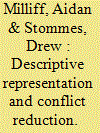

|
|
|
|
|
| Summary/Abstract |
Can greater inclusion in democracy for historically disadvantaged groups reduce rebel violence? Democracy-building is a common tool in counterinsurgencies and post-conflict states, yet existing scholarship has faced obstacles in measuring the independent effect of democratic reforms. We evaluate whether quotas for Scheduled Tribes in local councils reduced rebel violence in Chhattisgarh, an Indian state featuring high-intensity Maoist insurgent activity. These quotas did not originate as a counterinsurgency technique, but instead as an effort to address the longstanding political marginalization of India’s Scheduled Tribes. We employ a geographic regression discontinuity design to study the wartime effects of quotas implemented in Chhattisgarh, finding that reservations reduced Maoist violence in the state. Exploratory analyses of mechanisms suggest that reservations reduced violence by bringing local elected officials closer to state security forces, providing a windfall of valuable information to counterinsurgents. Our study shows that institutional engineering, like reforms to create more inclusive representative democracy, can shape the trajectory of insurgent violence. Institutional engineering creating more inclusive representative democracy during an ongoing conflict can affect the political economy of information sharing in civil war and, ultimately, affect the trajectory of insurgent violence.
|
|
|
|
|
|
|
|
|
|
|
|
|
|
|
|
| 2 |
ID:
192872
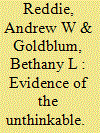

|
|
|
|
|
| Summary/Abstract |
Ongoing nuclear modernization programs in Russia, China, and the USA have reopened longstanding debates among scholars concerning whether tailored nuclear weapons are likely to have destabilizing consequences for international security. Without data to adjudicate this debate, however, these discussions have remained entirely theoretical. In this article, we introduce an experimental wargaming platform, SIGNAL, to quantify the effect of tailored nuclear capabilities on the nuclear threshold in a simulated environment. We then compare these results with a survey experiment using scenarios related to military basing, cyber operations, and nuclear threats from the wargame environment. While the survey experiments suggest that the presence of tailored nuclear capabilities increases the likelihood of conflict escalation, this trend diminishes in the wargaming context. Across both data-generating processes, we find support for the proposition that lower-yield nuclear weapons are used as a substitute for their higher-yield counterparts. These results have consequences for recent and ongoing policy debates concerning strategic posture and the future of arms control. This work also makes methodological contributions to the design and application of experimental wargaming for social science research, particularly for scenarios where data are limited or non-existent.
|
|
|
|
|
|
|
|
|
|
|
|
|
|
|
|
| 3 |
ID:
192870
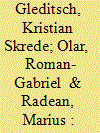

|
|
|
|
|
| Summary/Abstract |
We examine how popular dissent affects the likelihood that political leaders lose power, distinguishing between types of dissent in terms of nonviolent/violent primary tactics as well as the level of individual participation. We posit that protests threaten leaders both directly through the governance costs of citizen non-compliance, and indirectly through the increased risk of elite defections in the ruling coalition. In a series of propositions we detail how the type of dissent and the magnitude of participation influence the odds of leaders surviving in office. We argue that mass nonviolent challenges tend to be more threatening to a leader’s rule than violent dissent, given the characteristics of movements likely to choose nonviolent tactics. Moreover, the effectiveness of the challenge increases in the scale and size of the dissident campaign, and movements that can mobilize larger numbers have a comparative advantage in nonviolent tactics. Employing data on political leaders’ tenure and dissident campaign characteristics, we provide evidence consistent with our expectations.
|
|
|
|
|
|
|
|
|
|
|
|
|
|
|
|
| 4 |
ID:
192876
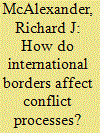

|
|
|
|
|
| Summary/Abstract |
Rebels can comply with international law during a conflict by not violating international borders, yet strategic goals may incentivize rebels to violate these borders. When do international borders affect the spatial and temporal distribution of rebel activity in a conflict setting? I theorize rebels have an incentive to refrain from violating borders when doing so will reduce their international legitimacy. When international legitimacy is a less important goal, rebels will be more likely to violate borders. I test this claim in the context of the 1948 War in Mandate Palestine by exploiting a quasi-natural experiment in how the 1947 UN partition line was drawn. Using an original dataset on over 1,000 Palestinian villages from British colonial documents and an atlas of aerial photographs of Palestine, I use a geographic regression discontinuity design to see how the UN partition line affected the location and timing of depopulated villages during the war. The results show that villages in areas that the UN assigned to the future Israeli state as part of the 1947 partition plan were more likely to be conquered before Israel received recognition. These findings have important implications for understanding where and when rebels target areas and shed new light on important dynamics of the 1948 War in Palestine.
|
|
|
|
|
|
|
|
|
|
|
|
|
|
|
|
| 5 |
ID:
192877
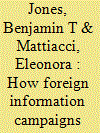

|
|
|
|
|
| Summary/Abstract |
Governments involved in civil wars often seek to shape foreign perceptions of the conflict and of the government’s role in the conflict. To this end, for example, many such governments have engaged in public diplomacy campaigns (PDCs) in the United States since the end of the Cold War. Specifically, these governments have hired US public relations (PR) and lobbying firms to present favorable narratives of themselves and their role in the conflict. Through PDCs, governments seek to shape US public pronouncements about the governments and the conflict itself. Are PDCs effective tools to reach this goal? We argue that the effect of PDCs is divergent. PDCs help mobilize both supporters and opponents of the sponsoring governments. In so doing, PDCs increase both positive and negative public statements from US officials toward the civil war government. We compile data on PDCs in the United States since the end of the Cold War. Our results have implications for research on foreign influence in foreign policy, combatants’ moral hazard, and international norms about combatant behavior. Moreover, in order to gauge the influence of foreign actors on domestic narratives of civil wars, it is crucial to consider how such foreign actors can indirectly shape the discourse around conflict by mobilizing domestic factions.
|
|
|
|
|
|
|
|
|
|
|
|
|
|
|
|
| 6 |
ID:
192879
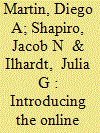

|
|
|
|
|
| Summary/Abstract |
This article introduces a dataset on the covert use of social media to influence politics by promoting propaganda, advocating controversial viewpoints, and spreading disinformation. Influence efforts (IEs) are defined as: (i) coordinated campaigns by a state, or the ruling party in an autocracy, to impact one or more specific aspects of politics at home or in another state, (ii) through media channels, including social media, by (iii) producing content designed to appear indigenous to the target state. Our data draw on more than 1,000 media reports and 500 research articles/reports to identify IEs, track their progress, and classify their features. The data cover 78 foreign influence efforts (FIEs) and 25 domestic influence efforts (DIEs) – in which governments targeted their own citizens – against 51 different countries from 2011 through early 2021. The Influence Effort dataset measures covert information campaigns by state actors, facilitating research on contemporary statecraft.
|
|
|
|
|
|
|
|
|
|
|
|
|
|
|
|
| 7 |
ID:
192871
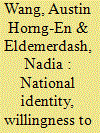

|
|
|
|
|
| Summary/Abstract |
Why do people risk their lives fighting in wars? This article looks beyond group grievance and material benefits to add another psychological mechanism explaining why people choose to fight or not to fight – perceived collective action. An individual is much more likely to fight when they perceive that others will also fight. Contrary to the expectations of social identity theory and social pressure theory, the effect of perceived collective action is stronger among those who have a weaker national identity because they are more likely to rationally calculate the chance of winning by accounting for others’ decisions. To mitigate the endogeneity in post-conflict cross-sectional surveys, we conduct a survey experiment (n = 1,001) in Taiwan manipulating perceptions of others’ willingness to fight in a potential China–Taiwan military conflict. Experimental evidence supports the hypotheses that perceived collective action works only on weak Taiwanese identifiers. The result holds in robustness checks and in another nationally representative survey.
|
|
|
|
|
|
|
|
|
|
|
|
|
|
|
|
| 8 |
ID:
192880
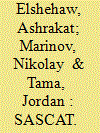

|
|
|
|
|
| Summary/Abstract |
Existing datasets of economic sanctions rely primarily on secondary sources and do not tend to take full advantage of government documents related to economic coercion. Such data may miss sanctions, and do not capture important details in how coercive measures are threatened, imposed and removed. The latter processes often have much to do with the domestic politics in sender countries. Understanding these processes may be necessary in order to fully account for sanctions’ effectiveness. We present a natural language processing (NLP) approach to retrieving sanctions-related government documents. We apply our method to the case of US sanctions. The United States is the world’s pre-eminent user of sanctions. Our method can be applied to other cases. We collect all sanctions events originating in the office of the US president, and all congressional sanctions, for 1988–2016. Our approach has three advantages: (1) by design, it captures all sanctions-related documents; (2) the resulting data are disaggregated by imposing branch of government; (3) the data include the original language of the measures. These features directly shed light on interbranch delegation, domestic (partisan) conflict, and policy priorities. We show that our data record more episodes than most existing sanctions’ data, and have features that other datasets lack. The availability of the original text opens up new avenues for research and analysis.
|
|
|
|
|
|
|
|
|
|
|
|
|
|
|
|
| 9 |
ID:
192878
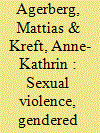

|
|
|
|
|
| Summary/Abstract |
The protection of civilians from human rights violations has increasingly become a global priority. The wars in Bosnia and Rwanda in the 1990s, and the development of the Women, Peace and Security framework have placed conflict-related sexual violence on the global protection agenda. Prior research has found that international attention to, and intervention in, conflicts is in fact more likely when there are reports of widespread sexual violence, regardless of overall conflict intensity. This article theorizes and empirically examines the micro-level underpinnings of these patterns. We hypothesize that individuals are more likely to support military intervention in conflicts with prevalent sexual violence as opposed to other types of conflict violence. The reason lies in gendered protection norms, based in benevolent sexism, that continue to have traction also in Western societies. In equivalent survey experiments carried out in the United States, the United Kingdom and Sweden, we find that support for international intervention is highest in sexual violence conflicts. In the United States and the United Kingdom, the responsibility to protect and gendered perceptions of victimhood mediate this effect. A follow-up experiment in the United States provides further evidence of a gendered protection norm as a core mechanism driving our results.
|
|
|
|
|
|
|
|
|
|
|
|
|
|
|
|
| 10 |
ID:
192873


|
|
|
|
|
| Summary/Abstract |
Theories explaining why states choose to use targeted or indiscriminate violence against civilians hinge on the state’s capacity to gain information about who to target and its ability to do enough damage to prevent defection to the rebel’s side. In contrast to these theories, I show that the choice of strategy depends on the characteristics of the community experiencing the violence, not the state employing it. This article argues that even when states can target certain civilians, they may choose to employ indiscriminate violence owing to the characteristics of the civilians’ social network structure. The state’s optimal strategy of violence is driven by two factors: the degree distribution of civilians’ social networks and the correlation between citizens’ motivation to leave a network and citizens’ value to other nodes in the network. When the degree distribution is uniform, and motivation and value are positively correlated, indiscriminate violence is more often preferred.
|
|
|
|
|
|
|
|
|
|
|
|
|
|
|
|
| 11 |
ID:
192874
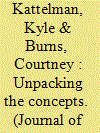

|
|
|
|
|
| Summary/Abstract |
In this article, we examine how changes in the status of women affect the intensity of terrorism by using three novel approaches. First, we link terrorist ideology more directly to women’s status using a well-tread topic in feminist literature that is rarely applied to political violence: misogyny. Second, we provide more explicit linkages to misogyny by disaggregating terrorist ideology into four typologies (ethnonationalist, religious, right-wing, and left-wing), arguing that the first three have strong themes of masculinity and patriarchy; ideologies when taken to their extremes distill into misogyny. Finally, previous efforts to study gender equality frequently suffer from imprecise theory and concept stretching. We sidestep this issue by instead focusing on women’s status and employ a new series of measures that broaden our understanding of women’s status from a rights-based approach to one that includes women’s security, inclusion, and legal rights. We do this by disaggregating 634 terrorist organizations to determine whether the level of specific women’s status indicators affects the frequency of violence from specific terrorist ideologies. We test this on a sample of 185 countries from 1970 to 2014 and find that increases in women’s security provoke violence from ethnonationalist and religious groups while increases in women’s legal rights incite violence from right-wing groups.
|
|
|
|
|
|
|
|
|
|
|
|
|
|
|
|
|
|
|
|
|